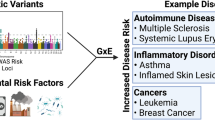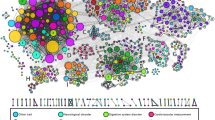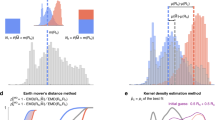Abstract
Genetic epidemiology deals with etiology, distribution, and control of disease in groups of relatives and with inherited causes of disease in populations. It took its first steps before its recognition as a discipline, and did not reach its present scope until the Human Genome Project succeeded. The intimate relationship between genetics and epidemiology was discussed by Neel and Schull (1954), just a year after Watson and Crick reported the DNA double helix, and 2 years before human cytogenetics and the Japan Society of Human Genetics were founded. It is convenient to divide the next half-century into three phases. The first of these (1956–1979) was before DNA polymorphisms were typed, and so the focus was on segregation and linkage of major genes, cytogenetics, population studies, and biochemical genetics. The next phase (1980–2001) progressively identified DNA polymorphisms and their application to complex inheritance. The last phase began with a reliable sequence of the human genome (2002), followed by exploration of genomic diversity. Linkage continues to be useful to study recombination and to map major genes, but association mapping gives much greater resolution and enables studies of complex inheritance. The generation now entering human genetics will have collaborative opportunities undreamed of a few years ago, without the independence that led to great advances during the past half-century.
Similar content being viewed by others
Log in or create a free account to read this content
Gain free access to this article, as well as selected content from this journal and more on nature.com
or
References
Allison AC (1964) Polymorphism and natural selection in human populations. Cold Spring Harbour Symp Quant Biol 24:137–149
Carlson EA (2004) Mendel’s legacy. The origin of classical genetics. Cold Spring Harbor Laboratory Press, Long Island
Collins A, Morton NE (1998) Mapping a disease locus by allelic association. Proc Natl Acad Sci USA 95:1741–1745
Collins A, Frezal J, Teague J, Morton NE (1996) A metric map of humans: 23,500 loci in 850 bands. Proc Natl Acad Sci USA 93:14771–14775
Cook-Deegan RM (1991) The human genome project: the formation of federal policies in the United States, 1986–1990. In: Hanna KE (ed) Biomedical politics. National Academy Press, Washington, DC
Crow JF (1987) Muller, Dobzhansky, and overdominance. J Hist Biol 20:351–380
Dalmasso C, Broet P, Moreau T (2004) A simple procedure for estimating the false discovery rate. Bioinformatics 21:660–668
Elston RC, Stewart J (1971) A general model for the genetic analysis of pedigree data. Hum Hered 21:523–542
Feder JN, Gnirke A, Thomas W, Tsuchihashi Z, Ruddy DA, Basava A, Dormishian F, Domingo R Jr, Ellis MC, Fullan A et al (1996) A novel MHC class I-like gene is mutated in patients with hereditary haemochromatosis. Nat Genet 13:399–408
Fujii T, Moloney WC, Morton NE (1955) Data on linkage of ovalocytosis and blood groups. Am J Hum Genet 7:72–75
Goodall HB, Hendry DWW, Lawler SD, Stephen SA (1953) Data on linkage in man: elliptocytosis and blood groups II. Family 3. Ann Eugen 17:272–278
Haga H, Yamoda R, Ohnishi Y, Nakamura Y, Tanaka T (2002) Gene-based SNP discovery as part of the Japanese Millennium Genome Project: identification of 190562 genetic variations in the human genome. J Hum Genet 47:605–610
Haldane JBS (1957) The cost of natural selection. J Genet 55: 511–524
Hill WG, Robertson A (1968) Linkage disequilibrium in finite populations. Theor Appl Genet 38:226–231
Imaizumi Y (1986) A recent survey of consanguineous marriages in Japan. Clin Genet 30:230–233
International HapMap Consortium (2005) A haplotype map of the human genome. Nature 437:1299–1320
International Human Genome Sequencing Consortium (2004) Finishing the euchromatic sequence of the human genome. Nature 431:931–945
Jeffreys AJ, Kauppi L, Neumann R (2001) Intensely punctate meiotic recombination in the class II region of the major histocompatibility complex. Nat Genet 29:217–222
Kerem B, Rommens JM, Buchanan JA, Markiewicz D, Cox TK, Chakravarti A, Buchwald M, Tsui L-C (1989) Identification of the cystic fibrosis gene: genetic analysis. Science 245:1073–1080
Kimura M (1960) Optimum mutation rate and degree of dominance as determined by the principle of minimum genetic load. J Genet 57: 21–34
Kimura M (1968) Evolutionary rate at the molecular level. Nature 217: 624–626
King M-C, Ree GM, Spinner NB, Thomson G, Wrensch MR (1984) Genetic epidemiology. Annu Rev Public Health 5:1–52
Lander E, Kruglyak L (1995) Genetic dissection of complex traits: guidelines for interpreting and reporting linkage results. Nat Genet 11:244–247
Lewontin RC (1964) The interaction of selection and linkage. I General considerations. Genetics 49:49–67
Lewontin RC (1975) Genetic aspects of intelligence. Annu Rev Genet 9:387–405
Lonjou C, Collins A, Ajioka RS, Jorde LB, Kushner JP, Morton NE (1998) Allelic association under map error and recombinational heterogeneity: a tale of two sites. Proc Natl Acad Sci USA 95:11366–11370
Lynn A, Ashley T, Hassold T (2004) Variation in human meiotic recombination. Annu Rev Genomics Hum Genet 5:317–349
Malecot G (1948) Les mathématiques de l’hérédité. Masson, Paris
Maniatis N, Collins A, Xu C-F, McCarthy LC, Hewett DR, Tapper W, Ennis S, Ke K, Morton NE (2002) The first linkage disequilibrium (LD) maps: delineation of hot and cold blocks by diplotype analysis. Proc Natl Acad Sci USA 99:2228–2233
Maniatis N, Morton NE, Gibson J, Xu C-F, Hosking LK, Collins A (2005) The optimal measure of linkage disequilibrium reduces error in association mapping of affection status. Hum Mol Genet 14:145–153
Mohr J (1951) Estimation of linkage between the Lutheran and the Lewis blood groups. Acta Pathol Microbiol Scand 29:339–344
Mohr J (1954) A study of linkage in man. Munksgaard, Copenhagen
Morton NE (1955) Sequential tests for the detection of linkage. Am J Hum Genet 7:277–318
Morton NE (1956) The detection and estimation of linkage between the genes for elliptocytosis and the Rh blood group. Am J Hum Genet 8:80–96
Morton NE (1959) Genetic tests under incomplete ascertainment. Am J Hum Genet 11:1–16
Morton NE (1982) Outline of genetic epidemiology. Karger, Basle
Morton NE (1998) Significance tests in complex inheritance. Am J Hum Genet 62:690–697
Morton NE (1997) Genetic epidemiology. Ann Hum Genet 61:1–13
Morton NE, Chung CS (1978) Genetic epidemiology. Academic Press, New York
Morton NE, Crow JF, Muller HJ (1956) An estimate of the mutational damage in man from data on consanguineous marriages. Proc Natl Acad Sci USA 42:855–865
Morton NE, Zhang W, Taillon-Miller P, Ennis S, Kwok P-Y, Collins A (2001) The optimal measure of allelic association. Proc Natl Acad Sci USA 98:5217–5221
Mullis KB, Faloona FA (1987) Specific synthesis of DNA in vitro via a polymerase-catalyzed chain reaction. Methods Enzymol 155:335–350
Nakamura Y (2005) Scientists create Japan’s largest BioBank for genetic studies of 47 common diseases (Interview). Affymetrix Microarray Bull 1:16–19
Neel JV, Schull WJ (1954) Human heredity. University of Chicago Press, Chicago
Neel JV, Morton NE, Schull WJ, McDonald DJ, Kodani M, Takeshima K, Anderson RC, Wood J, Brewer K, Wright S, Yamazaki J, Suzuki M, Kitamura S (1953) The effects of exposure of parents to the atomic bombs on the first generation offspring in Hiroshima and Nagasaki: (preliminary report). Jpn J Genet 28:211–218
Ott J (1976) A computer program for linkage analysis of general human pedigrees. Am J Hum Genet 28:528–529
Ozaki K, Ohnishi Y, Iida A, Akihiko S, Yamada R, Tsunoda T, Sato H, Hori M, Nakamura Y, Tanaka T (2002) Functional SNPs in the lymphotoxin-α gene that are associated with susceptibility to myocardial infarction. Nat Genet 32:650–654
Pawlowitski I-H, Edwards JH, Thompson EA (1997) Genetic mapping of disease genes. Academic, San Diego
Rao DC, Province MA (2001) Genetic dissection of complex traits. Academic, San Diego
Rao DC, Morton NE, Elston RC, Yee S (1977) Causal analysis of academic performance. Behav Genet 7:147–159
Rao DC, Morton NE, Cloninger CR (1979 Path analysis under generalized assortative mating. I Theory Genet Res 33:175–188
Rao DC, Morton NE, Lalouel JM, Lew R (1982) Path analysis under generalized assortative mating. II American IQ. Genet Res 39:187–198
Risch N, Merikangas K (1996) The future of genetic studies of complex human diseases. Science 273:1516–1517
Schull WJ, Neel JV, Hashizumi A (1966) Some further observations on the sex ratio among infants born to survivors of the atomic bombings of Hiroshima and Nagasaki. Am J Hum Genet 18:328–338
Simon M, Bourel M, Fouchet R, Genetet B (1976) Idiopathic hemochromatosis and HLA-antigens. Diabete Metab 2:113–118
Smith CAB (1953) The detection of linkage in human genetics. J R Stat Soc B 15:153–192
Smithies O (1955) Zone electrophoresis in starch gels: group variations in the serum proteins of normal human adults. Biochem J 61:629–641
Solomon E, Bodmer WF (1979) Evolution of sickle variant gene. Lancet 1(8122):923
Storey JD, Tibshirani R (2003) Statistical significance for genome-wide studies. Proc Natl Acad Sci USA 100:9440–9445
Suarez BK, Rice J, Reich T (1978) The generalized sib pair IBD distribution: its use in the detection of linkage. Ann Hum Genet 42:87–94
Sved JA (1971) Linkage disequilibrium and homozygosity of chromosome segments in finite populations. Theor Popul Biol 2:125–141
Tapper W, Collins A, Gibson J, Maniatis N, Ennis S, Morton NE (2005) A map of the human genome in linkage disequilibrium units. Proc Natl Acad Sci 102:11835–11839
Terwilliger JD (1995) A powerful likelihood method for the analysis of linkage disequilibrium between loci and one or more polymorphic marker loci. Am J Hum Genet 56:777–787
Thomas DC, Haile RW, Duggan D (2005) Recent developments in genomewide association scans: a workshop summary and review. Am J Hum Genet 77:337–345
Tjio JH, Levan A (1956) The chromosome number of man. Hereditas 42:1–6
Watson JD, Crick FHC (1953) Molecular structure of nucleic acids. Nature 171:737–738
Watson J, Cyranoski D (2005) Beset by practical hurdles, U.K. BioBank moves at sluggish pace. Nat Med 11:696
Yanase T (1997) Human genetics: past, present, and future, with special reference to major trends in Japan. Jpn J Hum Genet 42:265–316
Zhang W, Collins A, Maniatis N, Tapper W, Morton NE (2002) Properties of linkage disequilibrium maps. Proc Natl Acad Sci USA 99:17004–17007
Zhang W, Collins A, Morton NE (2004) Does haplotype diversity predict power for association mapping of disease susceptibility? Hum Genet 115:157–164
Author information
Authors and Affiliations
Corresponding author
Rights and permissions
About this article
Cite this article
Morton, N.E. Fifty years of genetic epidemiology, with special reference to Japan. J Hum Genet 51, 269–277 (2006). https://doi.org/10.1007/s10038-006-0366-9
Received:
Accepted:
Published:
Issue date:
DOI: https://doi.org/10.1007/s10038-006-0366-9



